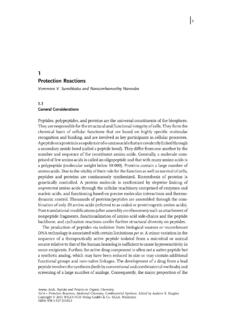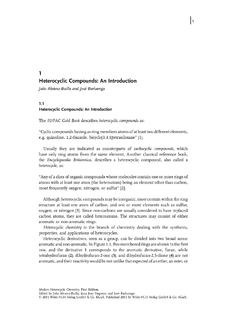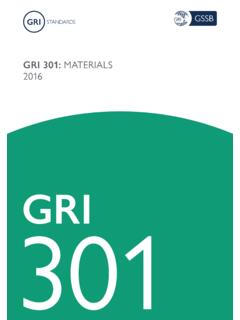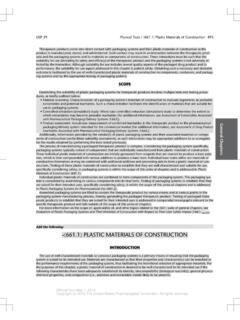Transcription of 1 Material Properties of Plastics - Wiley-VCH
1 1 Material Properties of and StructureThe basic structure of Plastics (or polymers) is given by macromolecule chains,formulated from monomer units by chemical reactions. Typical reactions for chainassembling are polyaddition (continuous or step wise) and condensation polymer-ization (polycondensation) [1] (Figure )..Polyaddition as chain reaction: Process by chemical combination of a largenumber of monomer molecules, in which the monomers will be combined toa chain either by orientation of the double bond or by ring splitting. No byproductswill be separated and no hydrogen atoms will be moved within the chain duringthe reaction. The process will be started by energy consumption (by light, heat orradiation) or by use of as step reaction: Process by combination of monomer units withouta reaction of double bonds or separation of low molecular compounds.
2 Hydrogenatoms can change position during the : Generation of Plastics by build up of polyfunctional com-pounds. Typical small molecules like water or ammonia can be set free during thereaction. The reaction can occur as a step monomer units are organic carbon-based molecules. Beside carbon andhydrogen atoms as main components elements like oxygen, nitrogen, sulfur,fluorineor chlorine can be contained in the monomer unit. The type of elements, theirproportion and placing in the monomer molecule gives the basis for generatingdifferent Plastics , as shown in Table coupling between the atoms of a macromolecular chain happens by primaryvalence bonding [2]. The backbone of the chain is built by carbon atoms linkedtogether by single or double bonding. Given by the electron configuration of carbonatoms, the link between the carbon atoms occurs at a certain angle, for example, forsingle bonding at an angle of.
3 Atoms like hydrogen, which are linked to thecarbon atoms, hinder the free rotation of the carbon atoms around the linking Welding of Plastics ,First Edition. Rolf Klein. 2011 Wiley-VCH Verlag GmbH & Co. KGaA. Published 2011 by Wiley-VCH Verlag GmbH & Co. cis -link of carbon atoms has the highest bonding energy while the "trans"-linkhas the lowest (Figure ) [3].Depending on the type of bonding partners several chain conformations arepossible. Examples of such conformations are zig-zag conformation ( , PE or PVC)or helix conformation ( , PP, POM or PTFE) (Figure ) [2].Figure for generating Plastics and examples [1].Table of some common Plastics and their (PE)PropylenePolypropylene (PP)VinylchloridePolyvinylchloride(PVC)C aprolactamePoly(E-Caprolactame)(PA6)Tetr aflourethylenePolytetraflourethylene(PTF E)4j1 Material Properties of PlasticsThe chain length and by this also the molecular weight of macromolecules have astatistical distribution [4] (Figure ).
4 By influencing the conditions of the polymer-ization process, the average molecular weight and the width of the distributionfunction can be controlled within certain the polymerization process, depending on the type of polymer, side chainscan be built to the main chain in a statistical way [5]. As for the length of the mainchain, frequency and length of the side chains depend on the macromolecularstructure and the physical/chemical conditions of the polymerization process [6].An example for the order of size of macromolecules is the length and width ofpolystyrene molecules with an average molecular weight of 105. Corresponding to themolecular weight the macromolecular chain consists of a number of approximatelyFigure energy for rotation of ethylene molecules around the carbon-linking axis [3].Figure types of Formation and Structurej52 105carbon atoms.
5 The average distance between each carbon atom 10 10m. Using this distance and the number of atoms in the chain takesto a length of 25 10 6m and 4 6 10 10m width for a stretched statistical forming of the macromolecular structure of Plastics results in thefact that physical Properties of Plastics , like temperatures of phase changes, can onlybe given as average values. Unlike materials like metals, phase changes of plasticsoccur in certain temperature ranges. The width of such temperature ranges isdependent on the homogeneity of the materials structure [6].The physical and chemical structure of the macromolecule is given by the primaryvalence bonding forces between the atoms (Figure ) [1]. The secondary valencebonding forces, like dispersion bonding, dipole bonding or hydrogen bridge bonds,have a direct influence to the macroscopic Properties of the plastic like mechanical,thermal, optical, electrical or chemical secondary valence forces are responsible for the orientation of the macro-molecules among themselves [6 8].
6 During processing of Plastics the orientation ofmolecule segments can result in an orientation of segments of the macromolecularchain. Under suitable conditions, like specific placements of atoms in the monomerstructure and by this within the macromolecular chain, a partial crystallization of theplastic is possible. The strength of the secondary valences is directly correlated withthe formation of the macromolecular chains. The strength increases with increasingcrystallization, with higher polarity between the monomer units, decreased mobilityof molecule segments and increased strapping of chains with others. Because of thesmall range and low energy of secondary valences in comparison with the mainvalences, effects caused by them are strongly temperature distribution of macromolecule chain length using polyvinylchloride (PVC) asan example [4].
7 6j1 Material Properties of PlasticsIn the case of possible atom bonds between macromolecular chains, a crosslinkingof the molecule structure can happen. While secondary valences can be dissolvedwith increasing temperatures and rebuilt during cooling, atom bonds cannot dissolvereversibly. By dissolving these bonds the plastic will be chemically the chemical structure and the degree of crosslinking between themacromolecules, Plastics can be classified as thermoplastics, elastomers and ther-mosets (Figure ) [1]. Compounds like polymer blends, copolymers and compositematerials are composed of several base materials. This composition can be done on aphysical basis ( , polymer blends or composite materials) or on a chemical basis(copolymers). of PlasticsCaused by the macromolecular structure and the temperature-dependent physicalproperties plastic materials are distinguished into different classes.
8 Figure givesan overview of the classification of Plastics with some typical are in the application range of hard or tough elasticity and can bemelted by energy input (mechanical, thermal or radiation energy). Elastomers are ofsoft elasticity and usually cannot be melted. Thermosets are in the application rangeof hard elasticity and also cannot be of molecular and macroscopic Material Properties [1]. Types of Plasticsj7 Figure structure of linear (A), with side chains (B) and crosslinked macromolecules(C D). Chain structure (A) and (B) are thermoplastic types, structures with low crosslinking (C)elastomers and with strong crosslinking thermosets (D).Figure of Material Properties of PlasticsPlastics as polymer mixtures are composed of two or more polymers withhomogeneous or heterogeneous structure. Homogeneous structures are for examplecopolymers or thermoplastic elastomers, built by chemical composition of two ormore different monomer units in macromolecules.
9 When using thermoplasticmonomers such plastic Material can be melted by thermal processes. Heterogeneousstructures are for example polymer blends or thermoplastic elastomers, built byphysical composition of separate phases from different polymers. Polymer blendswith thermoplastic components also can be melted by thermal composites consist of a polymeric matrix with integrated particles using thermoplastics as matrix, such composites can be melted. If thermosetsare used as matrix the composite cannot be of the different classes of Plastics are the phase transitions thatoccur in contrast to metallic materials in temperature intervals. Data given in tables( , [9]), are usually mean values of such temperature temperatures are dependent on the molecular structure of theplastic. Limited mobility of the molecule chains, for example, by loop forming, longside chains or high molecular weight cause an increased phase-transition temper-ature [6].
10 A large variance of the molecule chain length or number and length of sidechains also have an effect on the spreading of the phase-transition ResinsThermoplastic resins consist of macromolecular chains with no crosslinks betweenthe chains. The macromolecular chains themselves can have statistical oriented sidechains or can build statistical distributed crystalline phases. The chemistry andstructure of thermoplastic resins have an influence on the chemical resistance andresistance against environmental effects like UV radiation. Naturally, thermoplasticresins can vary from optical transparency to opaque, depending on the type andstructure of the Material . In opaque Material , the light is internally scattered by themolecular structure and direct transmission of light is very poor with increasingmaterial resins can be reversibly melted by heating and resolidified bycooling without significant changing of mechanical and optical Properties .












